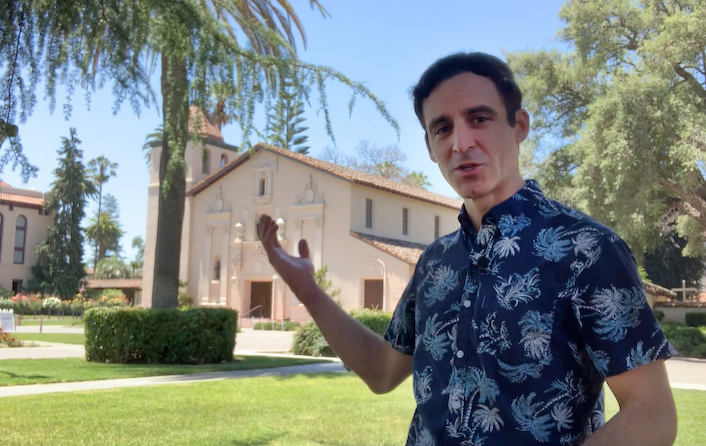
Embracing Change Means Being Resilient
Instead of written reports, Associate Professor Justin Boren asks students to create short video presentations.
Justin Boren was lucky: Having taught Santa Clara summer school classses online over the last four years, the associate professor of communication was ahead of the game when COVID-19 emptied SCU’s classrooms this spring.
While other faculty across the country were scrambling to learn how to use Zoom, he already knew. Boren also knew how to get around students’ shorter attention spans during remote learning.
So he created a series of “micro lectures” on particular topics, lasting no more then 15 minutes, supplementing those talks with demonstrations and creative videos. And this quarter, he is striving to make his talks “sparkle more” by breaking up his Zoom backgrounds, recording his sessions live from different locations—including near the Mission Church.
But how could he make the Biology of Human Communication, involving neuroscience and anatomy, and demonstrations with models of brains, work online and still meet his learning objectives?
Suddenly, it seemed, Boren was in the same boat as many of his colleagues: having to create a new teaching format.
“So I threw everything out,” he says, “and started from scratch.”
For the lab portion of Biology of Human Communication, he carted home some of his more portable lab gear and re-created those demonstrations on Zoom. He also leveraged videos on those topics from YouTube and other online sources.
“I was able to supplement anything that I was missing with other professionally-designed content,” says Boren.
Like his summer Zoom courses, he continues to pre-record his presentations, so students living in the U.S. and around the world can watch during a convenient hour in their time zones.
Boren also creates weekly “welcome videos” for each of his classes, providing personal insights into the topics the class will be studying that week.
And every Thursday, he offers a 60-minute drop-in Q&A period, a kind of office hours done online.
“I’m very honest with students,” Boren says. “I tell them all the time: ‘I will help you engage; the rest is up to you.’”
One way he is helping students engage is having them replace their written reports with short video presentations, which he says they like “because it’s not just a narrative piece.”
“I’ve learned that anything can be modified in a class,” says Boren of the changes that have been forced on faculty and staff during the pandemic. “We can’t walk into class and teach the same thing the same way we have taught for 10 years prior.”
For example, in his Quantitative Research Methods class, he teaches students about statistics. But he's found that doing that online is not as easy because he can’t expect the students to have the same kind of software he has access to in campus computer labs.
So Boren has re-worked the format by teaching students how to critique statistics from the perspective of the consumer of the research.
Students, he says, have found tremendous value in that approach, applying it to their everyday lives as they read news stories to determine what is real and what is fake.
“I think we have all learned that we can adjust,” says Boren of online education.
“The important message is that humans are pretty resilient. The upside is that much like the whole world has changed, so have we at Santa Clara. And in some ways, that is not necessarily a bad thing.”
Justin Boren tries to make his Zoom classes “sparkle” by changing up his backgrounds. Here, he set up his camera near the Mission.